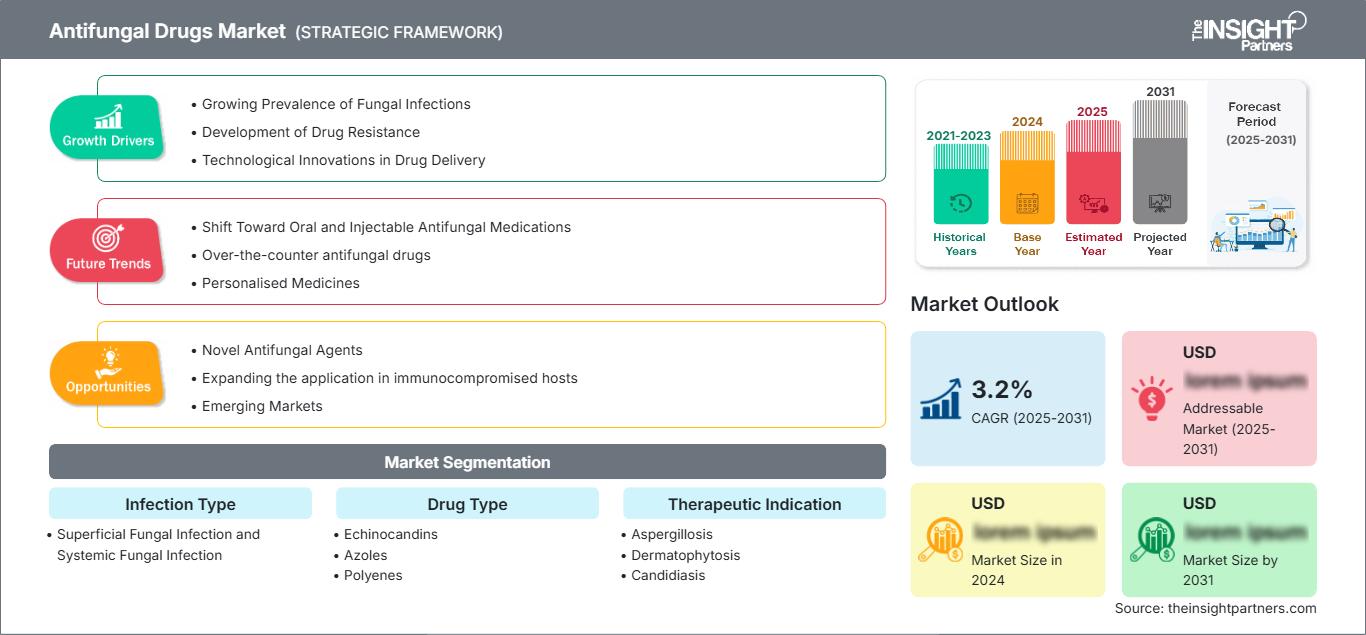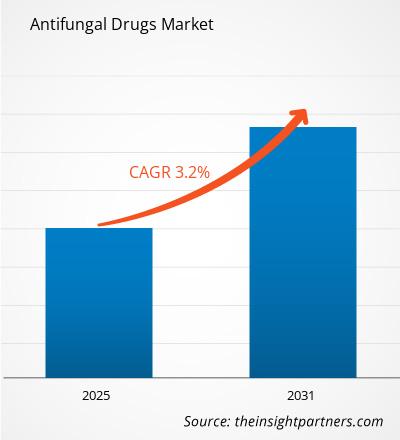Der Markt für Antimykotika wird bis 2031 voraussichtlich ein Volumen von 21,16 Milliarden US-Dollar erreichen. Für den Zeitraum 2025–2031 wird ein jährliches Wachstum von 4,2 % erwartet.
Der Bericht zum Markt für Antimykotika analysiert den Markt nach Infektionsart (oberflächliche und systemische Pilzinfektionen), Wirkstofftyp (Echinocandine, Azole, Polyene, Allylamine und andere), therapeutischer Indikation (Aspergillose, Dermatophytose, Candidiasis und andere) und Darreichungsform (Arzneimittel, Salbe, Pulver und andere). Die globale Analyse wird zudem auf regionaler Ebene und für wichtige Länder aufgeschlüsselt. Der Bericht gibt die Werte in US-Dollar für die oben genannten Analysen und Segmente an.
Zweck des Berichts
Der Bericht „Markt für Antimykotika“ von The Insight Partners beschreibt die aktuelle Marktlage und das zukünftige Wachstum, die wichtigsten Wachstumstreiber und Herausforderungen. Chancen. Dies wird verschiedenen Geschäftspartnern Einblicke bieten, wie zum Beispiel:
- Technologieanbieter/Hersteller: Um die sich entwickelnde Marktdynamik zu verstehen und die potenziellen Wachstumschancen zu erkennen, damit sie fundierte strategische Entscheidungen treffen können.
- Investoren: Um eine umfassende Trendanalyse hinsichtlich der Marktwachstumsrate, der Finanzprognosen und der Chancen entlang der Wertschöpfungskette durchzuführen.
- Regulierungsbehörden: Um Richtlinien zu regulieren und Aktivitäten auf dem Markt zu überwachen, mit dem Ziel, Missbrauch zu minimieren, das Vertrauen der Investoren zu erhalten und die Integrität und Stabilität des Marktes zu wahren.
Marktsegmentierung für Antimykotika: Infektionsart
- Oberflächliche Pilzinfektion und systemische Pilzinfektion
Arzneimitteltyp
- Echinocandine
- Azole
- Polyene
- Allylamine
Therapeutische Indikation
- Aspergillose
- Dermatophytose
- Candidiasis
- Sonstige
Darreichungsform
- Arzneimittel
- Salbe
- Pulver
Sie erhalten kostenlos Anpassungen an jedem Bericht, einschließlich Teilen dieses Berichts oder einer Analyse auf Länderebene, eines Excel-Datenpakets sowie tolle Angebote und Rabatte für Start-ups und Universitäten.
Markt für Antimykotika: Strategische Einblicke

-
Holen Sie sich die wichtigsten Markttrends aus diesem Bericht.Dieses KOSTENLOSE Beispiel umfasst Datenanalysen, die von Markttrends bis hin zu Schätzungen und Prognosen reichen.
Wachstumstreiber des Marktes für Antimykotika
- Zunehmende Verbreitung von Pilzinfektionen: Die zunehmende Verbreitung von Pilzerkrankungen wie Candidiasis und Aspergillose führt zu einer Expansion des Marktes. Die Marktanalyse hat die ungedeckte Nachfrage in Entwicklungsländern hervorgehoben.
- Entwicklung von Arzneimittelresistenzen: Laut Wettbewerbsanalysen treibt die steigende Nachfrage nach neuen Antimykotika zur Bekämpfung von Resistenzen das Wachstum des globalen Marktes an.
- Technologische Innovationen in der Arzneimittelverabreichung: Markttrends zufolge verbessern liposomale Formulierungen die Wirksamkeit von Medikamenten und tragen zum Wachstum bei, wie Marktberichte zeigen.
Zukünftige Trends des Marktes für Antimykotika
- Verlagerung hin zu oralen und injizierbaren Antimykotika: Orale und injizierbare Antimykotika gewinnen aufgrund ihrer systemischen Behandlungsmöglichkeiten, insbesondere bei schweren Infektionen, an Bedeutung. Die orale Therapie gewinnt bei der Behandlung systemischer Mykosen zunehmend an Marktanteilen, während die Injektionstherapie bei stationären Patienten mit schweren Infektionen weit verbreitet ist.
- Rezeptfreie Antimykotika: Rezeptfreie Antimykotika, insbesondere gegen häufige Pilzinfektionen der Haut wie Fußpilz und Ringelflechte, erfreuen sich steigender Nachfrage, da sie ohne Rezept leicht erhältlich sind.
- Personalisierte Medizin: Der wachsende Bereich der personalisierten Medizin führt dazu, dass die Behandlung von Pilzinfektionen immer stärker auf die individuellen Bedürfnisse und die genetische Ausstattung der Patienten abgestimmt wird. Dies erhöht das Potenzial für Wirksamkeit bei gleichzeitiger Minimierung von Nebenwirkungen.
Marktchancen für Antimykotika
- Neue Antimykotika: Pharmaunternehmen haben große Chancen, neue Antimykotika zu entwickeln, um dem zunehmenden Problem der Arzneimittelresistenz, insbesondere gegen Pilze wie Candida auris und Aspergillus-Arten, entgegenzuwirken. Innovative Behandlungen, die gezielt gegen resistente Stämme wirken, stellen einen dringenden Marktbedarf dar.
- Erweiterung des Anwendungsbereichs bei immungeschwächten Patienten: Angesichts der Zunahme von Erkrankungen wie HIV, Krebs und Organtransplantationen bei immungeschwächten Patienten wächst der Bedarf an präventiven und therapeutischen Antimykotika.
- Schwellenländer: In Schwellenländern besteht ein enormes Marktpotenzial, da sich die Gesundheitsinfrastruktur in diesen Regionen verbessert. Das gestiegene Bewusstsein, die verbesserte Diagnostik und der verbesserte Zugang zur Gesundheitsversorgung eröffnen Herstellern von Antimykotika die Möglichkeit, in Regionen wie Asien-Pazifik, Lateinamerika und den Nahen Osten einzutreten.
Markt für Antimykotika
Die regionalen Trends und Einflussfaktoren auf den Markt für Antimykotika im gesamten Prognosezeitraum wurden von den Analysten von The Insight Partners ausführlich erläutert. Dieser Abschnitt behandelt außerdem die Marktsegmente und die geografische Verteilung des Marktes für die Behandlung von Herzrhythmusstörungen in Nordamerika, Europa, dem asiatisch-pazifischen Raum, dem Nahen Osten und Afrika sowie Süd- und Mittelamerika.
Umfang des Marktberichts zu Antimykotika
| Berichtsattribut | Einzelheiten |
|---|---|
| Marktgröße in 2024 | US$ XX Billion |
| Marktgröße nach 2031 | US$ 21.16 Billion |
| Globale CAGR (2025 - 2031) | 4.2% |
| Historische Daten | 2021-2023 |
| Prognosezeitraum | 2025-2031 |
| Abgedeckte Segmente |
By Infektionstyp
|
| Abgedeckte Regionen und Länder |
Nordamerika
|
| Marktführer und wichtige Unternehmensprofile |
|
Dichte der Marktteilnehmer im Bereich der Antimykotika: Auswirkungen auf die Geschäftsdynamik
Der Markt für Antimykotika wächst rasant, angetrieben durch die steigende Nachfrage der Endverbraucher. Gründe hierfür sind unter anderem sich wandelnde Verbraucherpräferenzen, technologische Fortschritte und ein wachsendes Bewusstsein für die Vorteile des Produkts. Mit steigender Nachfrage erweitern Unternehmen ihr Angebot, entwickeln innovative Produkte, um den Bedürfnissen der Verbraucher gerecht zu werden, und nutzen neue Trends, was das Marktwachstum zusätzlich beflügelt.

- Holen Sie sich die Markt für Antimykotika Übersicht der wichtigsten Akteure
Wichtigste Verkaufsargumente
- Umfassende Abdeckung: Der Bericht bietet eine umfassende Analyse der Produkte, Dienstleistungen, Typen und Endnutzer des Marktes für Antimykotika und vermittelt so ein ganzheitliches Bild.
- Expertenanalyse: Der Bericht basiert auf dem fundierten Wissen von Branchenexperten und Analysten.
- Aktuelle Informationen: Der Bericht gewährleistet Geschäftsrelevanz durch die Berücksichtigung aktueller Informationen und Datentrends.
- Anpassungsmöglichkeiten: Dieser Bericht kann an spezifische Kundenanforderungen angepasst werden und sich optimal in die Geschäftsstrategien integrieren.
Der Forschungsbericht zum Markt für Antimykotika kann somit maßgeblich dazu beitragen, das Branchenszenario und die Wachstumsaussichten zu entschlüsseln und zu verstehen. Auch wenn einige berechtigte Bedenken bestehen, überwiegen die Vorteile dieses Berichts insgesamt die Nachteile.
- Historische Analyse (2 Jahre), Basisjahr, Prognose (7 Jahre) mit CAGR
- PEST- und SWOT-Analyse
- Marktgröße Wert/Volumen – Global, Regional, Land
- Branchen- und Wettbewerbslandschaft
- Excel-Datensatz
Aktuelle Berichte
Verwandte Berichte
Erfahrungsberichte
Grund zum Kauf
- Fundierte Entscheidungsfindung
- Marktdynamik verstehen
- Wettbewerbsanalyse
- Kundeneinblicke
- Marktprognosen
- Risikominimierung
- Strategische Planung
- Investitionsbegründung
- Identifizierung neuer Märkte
- Verbesserung von Marketingstrategien
- Steigerung der Betriebseffizienz
- Anpassung an regulatorische Trends






















 Kostenlose Probe anfordern für - Markt für Antimykotika
Kostenlose Probe anfordern für - Markt für Antimykotika